The Best Cut of Beef for Clarifying Consommãƒâ© Is
by Dave Arnold
At this year’s Star Chefs conference I whipped up some beaver-flapper puffs for the crowd to munch on (see here for recipe), and Nils and I liquored everyone up with a passel of cocktails.
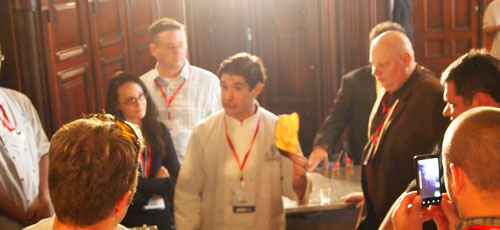
Our 75 minute demo showcased three different techniques at three different attainability levels: rapid N2O infusion (within anyone’s reach); centrifugation (uncommon, but not beyond reach); and rotary evaporation (out of most people’s reach).
Rapid Infusion:
Rapid infusion makes flavored liquors almost instantly using nothing more than an iSi whipped cream whipper. This technique works really well, and anyone can do it. Briefly: put any porous item into a cream whipper, charge it with N2O, swirl it for about a minute, vent, strain, and drink. Read this post for my blow by blow.
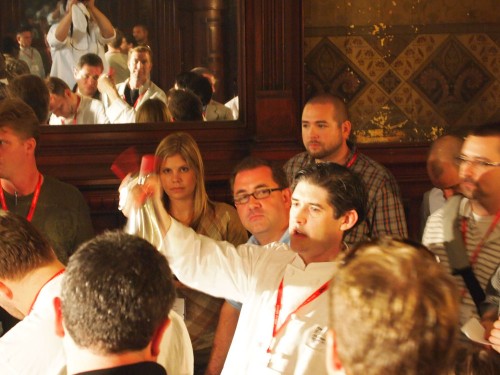
Many readers have commented that the liquors they’ve made with this technique improve after standing for several minutes. I have also noticed this effect, but I don’t understand it (comments anyone?)
We made three cocktails with rapid infusion:
Spicy Ballsy Bullshot:
The standard bullshot is beef bouillon, vodka salt and pepper. Beef bouillon isn’t so great, and you wish you could use reduced beef or veal stock â€" but high gelatin content makes the stocks solid jellies at cocktail temperatures. What to do? Get rid of the gelatin. Freeze-thaw clarifying removes the gelatin from stock so you can reduce it a lot without turning it to glue (see the technique here). We made a very, very beefy 1 liter of reduction from 2 gallons of stock. We wanted to add some spice to the vodka so we used rapid N2O infusion to add some jalapeno flavor. Most hot pepper infusions tend to get very spicy without tasting a lot like peppers. N2O infusions capture both heat and taste. We garnished with a pickled cherry tomato, which made the drink supremely satisfying. It’s best enjoyed at the beginning of your evening or brunch, as a bracing short-poured drink â€"which is how we served it.
Ingredients:
8 liters veal stock
Water (the amount depends on how jellied your stock is)
1 liter vodka
60 grams of seeded sliced jalapeno pepper
4-8 gram N2O Chargers
Lime juice
Splash of water
Salt
Pickled cherry tomatoes
Freeze-thaw stock technique:
Add enough water (or vegetable stock) to the veal stock so that, when set, the stock won’t be too gelatinous. Heavily set stock won’t work â€"your yields will be low and the stock will take forever to clarify. Ideally, the stock shouldn’t fully set at all (you want the equivalent of 5-7 grams of sheet gelatin per liter of liquid, if that is helpful). Heat the stock to make sure it is homogeneous, pour it into 2 hotel pans, and let the pans sit in the fridge a couple of hours (this gives the gelatin time to cool down and do its thing). Freeze the stock overnight, or until completely frozen. Line 2 perforated hotel pans with 4 layers of cheesecloth and add the frozen stock (don’t use a torch to get the frozen stock out of the hotel pans! Use brute force). Place the perforated pans over deep hotel pans and let the stock thaw for a day or two in the fridge; make sure your fridge isn’t too cold. The liquid that drips from the thawing block will be clarified veal stock without gelatin (for more on clarification see here). After the clarification step, reduce the stock down to 1 liter.
An alternate, faster technique: clarify the consommé in the traditional manner with an egg raft, allow it to cool down to 40 Celsius, and add 1 gram or so of Corolase 7089 enzyme per liter. Corolase (from AB Enzymes) will eat the gelatin. Wait half an hour and reduce your stock to 1 liter.
Jalapeno vodka technique:
Divide your jalapeno and vodka into 2 batches. Add one of the batches to a half-liter ISI cream whipper, charge with 2 N2O chargers, agitate for 1 minute, then vent and open the whipper. Allow to rest for 1 minute, then strain the pepper from the vodka. Repeat with the second batch and allow the liquor to rest for 10 minutes before using.
The drink:
Mix vodka and consommé in equal parts. Add lime juice and salt to taste. You may add water if it’s too strong for you, or an ice cube or two, and chill it in the fridge or freezer ‘til it suits your fancy. Serve in shots garnished with a peeled pickled cherry tomato.
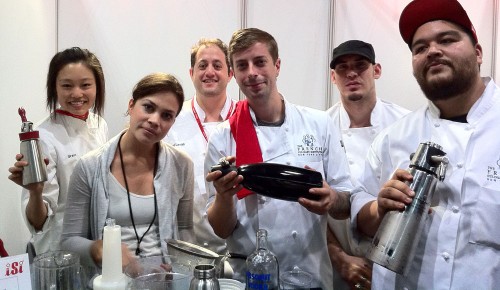
Chocolate N’Lemons, the Germanfrancisco Treat:
My wife is the inspiration for this drink; while living in Frankfurt for four years she picked up a taste for eating chocolate ice cream with lemon sorbet. For the drink base we made a chocolate vodka with cocoa-nibs; good tasting nibs, like Valrohna’s, are essential for this recipe. We have tried three other types of nibs, including some expensive ones, and we don't like any them. Look for nibs that don’t taste burned or overly acidic.
Ingredients:
500 ml vodka
75 grams Valrhona cocoa nibs
2-8 gram N2O chargers
Lemon juice
Simple syrup 1:1
Candied Ginger
Pinch salt
Chocolate vodka technique:
Add the nibs and the vodka to a half-liter cream whipper (changing the size might change the recipe). Charge with 8 grams N2O and swirl/shake for several seconds, then charge with an additional 8 grams of N2O. Continue to agitate for a full minute and let rest an additional 20 seconds, then vent and open the whipper (here’s a tip: hold a quart container over the whipper as you vent;  once the whipper starts to sputter tilt the container to catch the liquid. You don't lose liquid and don't make a mess). Allow the liquor to stay in the whipper for another minute or so, until the bubbling starts to subside). Strain out the nibs and pass the vodka through a coffee filter. Allow to rest several minutes before using. The leftover nibs aren't very good –all that remains is the bitterness.
The drink:
Combine 2 parts chocolate vodka, ¼ part lemon juice, 1/3 to 1/2 part simple syrup, and a dash of salt. Stir briefly with ice, strain into an old fashioned glass, and garnish with candied ginger. This recipe requires very little sugar, even though the cocoa nibs are unsweetened, because the infusion technique leaves the bitterness behind.
Bangkok Daiquiri
A fairly straight-ahead daiquiri recipe, using rum that we infused with Thai basil, cilantro, and orange peel. Though daiquiris are normally made with white rum we tried this recipe with the aged rum by our sponsor, Zacapa — different, but still great.
Ingredients: makes 2
150 ml rum
10 grams Thai basil
5 grams cilantro
10 grams orange peel (pith removed)
ISI cream whipper
N2O charger
1 oz simple syrup 1:1 (can be increased to 1 1/2 oz for a sweeter drink)
1 1/2 oz strained fresh lime juice
Pinch salt
Technique:
Add the rum, Thai basil, cilantro, and orange peel to the whipper and charge with N2O. Swirl the whipper for 30 seconds, allow to rest for 30 seconds more, give it a final swirl and vent the N2O to atmosphere.  While venting, hold the whipper upright so the liquid stays inside. If possible, let rest another 30 seconds. Open the whipper and strain the infused rum into a metal shaker. Add simple syrup, lime juice and salt and shake vigorously with plenty of ice for 12-15 seconds. Strain into 2 coupes. Drink.
Centrifugation:
Centrifuges separate mixtures based on density â€" like oil from water, or solids from liquids — by spinning very quickly. The spinning generates centrifugal force that causes products to separate that would never separate due to the force of gravity alone.
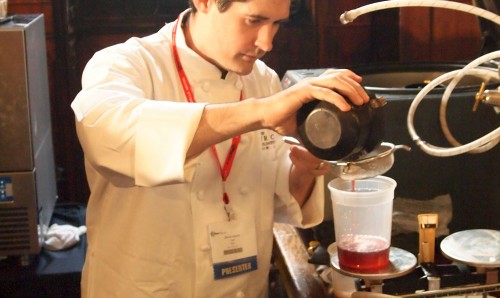
There are several reasons centrifuges aren’t widespread in kitchens. They are expensive. They can be dangerous. And, perhaps most importantly, chefs just don’t know which ones to buy. Centrifuges that don’t spin fast enough or have inadequate capacity are useless, and centrifuges that have more capabilities than a chef needs are huge, mega-expensive, and therefore worse than useless. After a couple years of testing I recommend one type of inexpensive and versatile centrifuge: the 3-liter benchtop. As the name implies, these guys can handle 3 liters per batch in their swinging bucket rotors, and the good ones can generate force in excess of 4000 times the force of gravity. They are about 2 ft x2 ft x1ft.
I have two Jouan 3-liter centrifuges, which I mainly use to clarify juice. I paid a grand total of 350 dollars including shipping for both because I’m an eBay ninja. If your kung-fu isn’t as strong, expect to pay $1000-$1200 a pop. Even at that price they pay themselves back pretty quickly if you make a lot of juice. With both of them running I can clarify about 18 liters per hour. Yields are incredible â€"much higher than with any other clarification technique. Expect 75-95% yield depending on the water content of your product. The basic technique: blend fruit in a Vita-Prep either alone or with a liquid (usually liquor), add 2 grams of Pectinex SP-L enzyme per liter or product (the enzyme breaks down the fruit’s pectin and hemicelluloses that prevent complete clarification. You can get some from us), let the puree rest for 20 minutes (so the enzyme can do its thing), and spin it at 4000 times the force of gravity for 15 minutes. Strain the juice and put it through a coffee filter. The solids will be left behind in the form of a sometimes delicious puck of sludge.
Here are the drinks we made with the fuge:
Bananas Justino (pronounced who-steeno)
We made this drink for the Star Chef Congress Cocktail party.
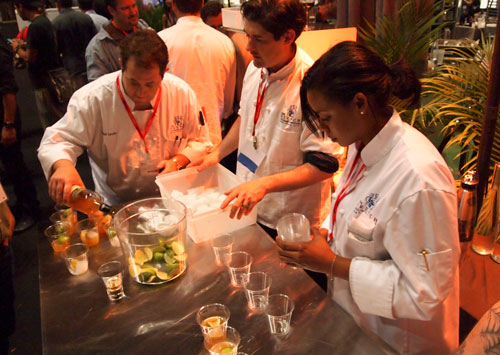
We blend bananas, vanilla bean and Zacapa 23 rum, then clarify; pour over coconut water ice cubes (start with Taste Nirvana coconut water, the best we’ve found) squeeze in a lime and toss in a star anise for aroma. Done.
Ingredients:
Zacapa 23 Solera Rum
Bananas
Vanilla beans
Pectinex SP-L
Limes
Water
Coconut Water
Star Anise pods
Technique:
Per 750 ml bottle of rum add 3 ripe bananas, half a vanilla bean, and 2 grams Pectinex SP-L. Blend in a Vita Prep and let rest 20 minutes. Spin at 4000 g’s for 15 minutes and strain through a chinois and then through a coffee filter. Freeze coconut milk into 1 ounce ice cubes. Put ice cubes in an old fashioned glass, pour banana rum over the ice, stir briefly, then squeeze a quarter lime into the glass and garnish with star anise. If you want you can keep the rum cold and water it slightly before pouring. If your limes aren’t juicy enough you can add some extra lime juice. Damn delicious.
September Issue
This is the drink I made for Jeffrey Steingarten and Dave Chang’s Vogue party during Fashion Week. It’s based on concord grapes and rye whiskey. We used McKenzie Rye from the Finger Lakes Distillery because it has a strong rye nose (smells just like the grain) that stays with the drink even after it’s mixed. We used Root, a delicious root beer liquor from Pennsylvania, like you would bitters â€"just a couple of dashes per drink. It doesn’t make the drink taste like root beer â€"it just rounds it out. For acidity we used lemon, and for sweetness we used maple syrup. Everything but the lemon is local to us New Yorkers. We garnished the whole shebang with maple-candied lemon peel.
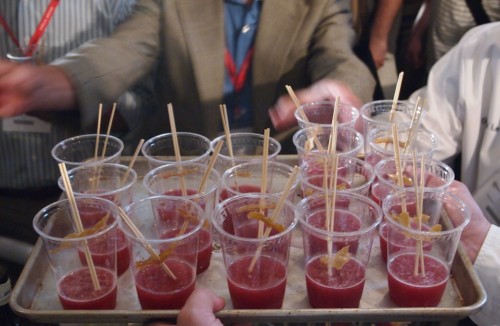
We made our own concord grape juice. It’s a pain in the behind, but worth it. No store-bought concord is as good as the stuff you make yourself, since you can control just how long the pulp stays with skins. Unfortunately you can’t just blend concord grapes to make juice. If you blend them, the seeds will make a tannic, bitter juice. So you have to crush the grapes instead. We first passed the grapes through an old-school ice crusher, then added enzyme and processed them in a modified chocolate grinder. After that, we clarified them in the centrifuge.
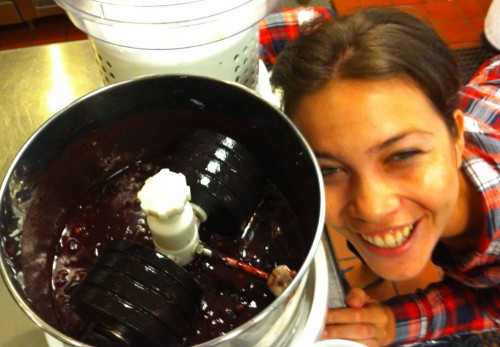
We served this drink with a side-shot of Nils’ favorite â€"Scotch and dry roasted peanuts blended and re-distilled in our rotary evaporator â€" to make our version of a peanut butter and jelly drink. Not an original combination, but a delicious one worth revisiting.
Ingredients:
2 Parts McKenzie Rye
1.3 parts concord grape juice
1 part water
0.5 parts strained lemon juice
0.25 parts maple syrup (grade B)
Pinch salt
3 dashes Root Liquor per 2 oz rye
Maple-Candied Lemon Peel (recipe below)
Technique:
Mix everything but the lemon peel together and chill it with liquid nitrogen (or mix it before hand, freeze it and shake it in a quart container; see my post on Cocktail Science).
Maple-Candied Lemon Peel
People seem to like these â€"I know I do. Just peel long slices of lemon rind off the lemon (we get 8 per lemon), making sure to get only the flavedo (the yellow part) and not the albedo (the white part). Blanch the peels 3 times quickly in boiling water and shock them in ice water. Vacuum bag them with cold maple syrup and simmer the bag in water for 20 minutes. Cut open the bag and put the peels and syrup in a pan to reduce the maple syrup a bit so the peels will gel when cooled. I don’t know the temperature; we do it by eye. Lay the peels on a silpat to dry.
Carbonated Figroni
Hendricks gin, Aperol, clarified mission figs, a squeeze of lime, and bubbles. What could be better? How about that same cocktail garnished with a cucumber that’s vacuum-infused with Hendricks, Dolin white vermouth (not the dry one), simple syrup and salt.
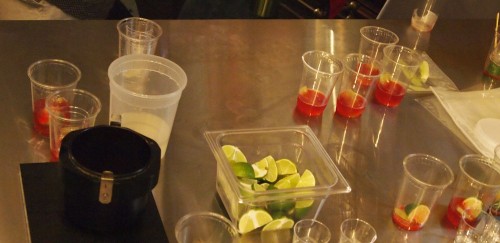
Ingredients:
2 parts Hendricks gin
2 parts Aperol
2.5 parts clarified mission fig juice (blend figs with enzyme and centrifuge as above â€"just make sure to clean and trim the figs well so they don’t have a dirty aroma)
Pinch of salt
CO2
Technique:
Mix everything together, chill and carbonate 3 times at 40 psi (you carbonate three times to get rid of entrained air and bubble nucleation sites). Garnish with a squeeze of lime and a vacuum infused cucumber.
Rotary Evaporation:
Rotary evaporators are laboratory vacuum stills. They operate at low temperatures in a low-oxygen environment. They can preserve flavors that might be damaged during ordinary distillation. Rotovaps are also very efficient at recovering all the flavors in a distillation rather than letting them boil into the ether. Walk into a room with a properly running rotovap and you smell nothing â€"all the aroma is in the booze. For a full explanation, see the Rotovap primer.
Even though it is illegal to distill alcohol (even for personal consumption, even if you don’t sell it) I always distill alcohol-based mixtures because I have found water based distillations weak and disappointing â€"until now. I have recently developed a technique for legal distillation using water â€"see my post on legal distillation. I’m not yet 100 percent satisfied with the technique, but Starchefs was the first time I have demo’d legal distillation in public, and people seemed to enjoyed it. I made a legal Thai basil and orange peel liquor so folks could compare it to the Bangkok Daiquiri (instructive, even though the spirit base was different.)

Lastly, we presented a rotovap concept piece â€"definitely not feasible for a bar:
Beaumes de Venise Mutant Sidecar
Beaumes de Venise (BdV) is a sweet Muscat wine from the Rhône Valley. We like it a lot. We also like the brandy that we make from it in our rotary evaporator. Since one of the main flavor notes of the traditional side-car is orange, we thought the Muscat-redolent BdV-brandy would be great in a sidecar. We had two problems â€"the sidecar needs the oak flavor of an aged brandy to be balanced properly (which our BdV brandy didn’t have), and distilling the alcohol off the BdV left us with a lot of left over de-alcoholed wine that we didn’t want to waste. Normally, we would reduce the leftover wine at around 45 C in the rotary evaporator to syrup. BdV syrup is nectar of the gods, but it takes a long time to make. I didn’t have five hours of constant attention to devote, so instead we made the leftover wine into a fantastic sorbet using liquid nitrogen. We served the sorbet as a sidecar to the sidecar.
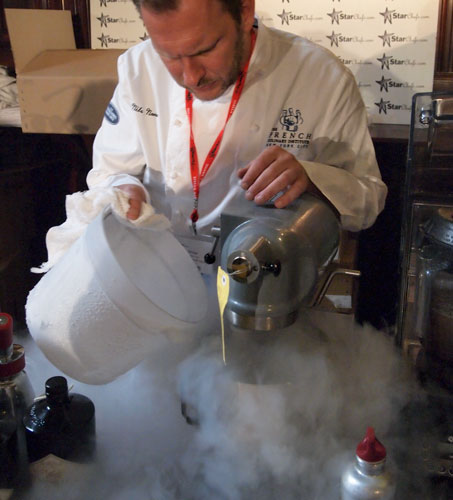
For the missing oak, I distilled some VSOP cognac in the rotovap and was left with a clear cognac distillate that retained a lot of the cognac’s character, but didn’t have any of the non-volatile oak notes that characterize an aged spirit. What was left over was a reduced solution of aged oak essence. We served the clear cognac as-is and added the oak to our BdV brandy to make “aged†BdV brandy with which we made a traditional sidecar:
Ingredients:
2 parts mutant BdV brandy
1 part Cointreau
1/2 part strained lemon juice
Pinch salt
Shake and drink.
We finished only 5 minutes over our allotted time, after which we caught a breath â€"and a drink.
smiththerecomed1949.blogspot.com
Source: https://cookingissues.com/2010/09/29/star-chiefs-the-cocktail-demo-with-recipes/
0 Response to "The Best Cut of Beef for Clarifying Consommãƒâ© Is"
Post a Comment